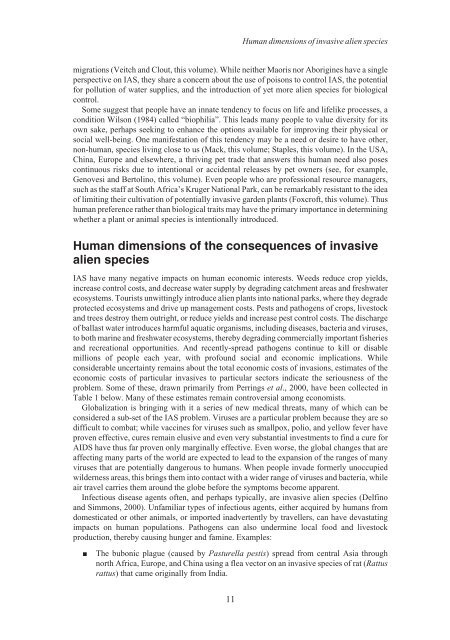Alien Species.vp - IUCN
Alien Species.vp - IUCN
Alien Species.vp - IUCN
You also want an ePaper? Increase the reach of your titles
YUMPU automatically turns print PDFs into web optimized ePapers that Google loves.
migrations (Veitch and Clout, this volume). While neither Maoris nor Aborigines have a single<br />
perspective on IAS, they share a concern about the use of poisons to control IAS, the potential<br />
for pollution of water supplies, and the introduction of yet more alien species for biological<br />
control.<br />
Some suggest that people have an innate tendency to focus on life and lifelike processes, a<br />
condition Wilson (1984) called “biophilia”. This leads many people to value diversity for its<br />
own sake, perhaps seeking to enhance the options available for improving their physical or<br />
social well-being. One manifestation of this tendency may be a need or desire to have other,<br />
non-human, species living close to us (Mack, this volume; Staples, this volume). In the USA,<br />
China, Europe and elsewhere, a thriving pet trade that answers this human need also poses<br />
continuous risks due to intentional or accidental releases by pet owners (see, for example,<br />
Genovesi and Bertolino, this volume). Even people who are professional resource managers,<br />
such as the staff at South Africa’s Kruger National Park, can be remarkably resistant to the idea<br />
of limiting their cultivation of potentially invasive garden plants (Foxcroft, this volume). Thus<br />
human preference rather than biological traits may have the primary importance in determining<br />
whether a plant or animal species is intentionally introduced.<br />
Human dimensions of the consequences of invasive<br />
alien species<br />
IAS have many negative impacts on human economic interests. Weeds reduce crop yields,<br />
increase control costs, and decrease water supply by degrading catchment areas and freshwater<br />
ecosystems. Tourists unwittingly introduce alien plants into national parks, where they degrade<br />
protected ecosystems and drive up management costs. Pests and pathogens of crops, livestock<br />
and trees destroy them outright, or reduce yields and increase pest control costs. The discharge<br />
of ballast water introduces harmful aquatic organisms, including diseases, bacteria and viruses,<br />
to both marine and freshwater ecosystems, thereby degrading commercially important fisheries<br />
and recreational opportunities. And recently-spread pathogens continue to kill or disable<br />
millions of people each year, with profound social and economic implications. While<br />
considerable uncertainty remains about the total economic costs of invasions, estimates of the<br />
economic costs of particular invasives to particular sectors indicate the seriousness of the<br />
problem. Some of these, drawn primarily from Perrings et al., 2000, have been collected in<br />
Table 1 below. Many of these estimates remain controversial among economists.<br />
Globalization is bringing with it a series of new medical threats, many of which can be<br />
considered a sub-set of the IAS problem. Viruses are a particular problem because they are so<br />
difficult to combat; while vaccines for viruses such as smallpox, polio, and yellow fever have<br />
proven effective, cures remain elusive and even very substantial investments to find a cure for<br />
AIDS have thus far proven only marginally effective. Even worse, the global changes that are<br />
affecting many parts of the world are expected to lead to the expansion of the ranges of many<br />
viruses that are potentially dangerous to humans. When people invade formerly unoccupied<br />
wilderness areas, this brings them into contact with a wider range of viruses and bacteria, while<br />
air travel carries them around the globe before the symptoms become apparent.<br />
Infectious disease agents often, and perhaps typically, are invasive alien species (Delfino<br />
and Simmons, 2000). Unfamiliar types of infectious agents, either acquired by humans from<br />
domesticated or other animals, or imported inadvertently by travellers, can have devastating<br />
impacts on human populations. Pathogens can also undermine local food and livestock<br />
production, thereby causing hunger and famine. Examples:<br />
■ The bubonic plague (caused by Pasturella pestis) spread from central Asia through<br />
north Africa, Europe, and China using a flea vector on an invasive species of rat (Rattus<br />
rattus) that came originally from India.<br />
11<br />
Human dimensions of invasive alien species












